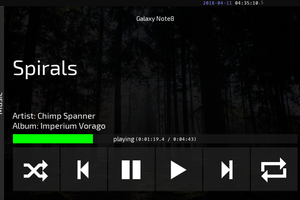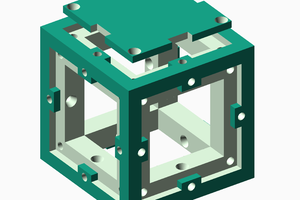Open Source Kinect stand-alone 3D Scanner
The idea behind this project is to provide an open-source stand-alone
Kinect and Raspberry Pi2 based 3D Scanner.
The idea behind this project is to provide an open-source stand-alone
Kinect and Raspberry Pi2 based 3D Scanner.
To make the experience fit your profile, pick a username and tell us what interests you.
We found and based on your interests.
Many people ask for a software during the last year. Until last year this was only a proof of concept project for me. But the good news is that i will make it happen. I am working simultaneously on the FabScanPi project . Most of the FabScanPi software can be reused for this project. Thats the reason why i prepared the FabScanPi software to add a module for Kinect support in the last month.
So if you want to stay up to date, follow also the FabScanPi project.
I was able to compile some software for the scanner. And hopefully this software will work. I had not the time to test it until now but come and visit our booth at Berlins first Maker Faire on 3th and 4th of October. You can find this project at the booth of "Freie Maker".
I will bring this project to the ccc camp from 13 - 17 August for working on the software.
I had to finish the Software of my other project FabScan Pi. But today i will start to write the Software for the Kinect Scanner.
The project is in an early state now. But you can find compiling instructions for the libfreenect kinect library and raspberry pi at http://www.mariolukas.de/2015/04/proof-of-concept-3d-scanner-with-kinect-and-raspberry-pi2
A first test of using a Kinect with Raspberry Pi2 is done. Libfreenect compiles without any problems on a Raspberry Pi2.
Create an account to leave a comment. Already have an account? Log In.
any progress..... I have all parts and are willing to test code for you
hello I love your project I would like to know which
material did you use and Could you send me more information? e-mail:cnslkc_19997@hotmail.com
Hi, I was very interested in your project and I would like to know if you could send me more information so I can prepare a clone here and I try to understand the operation.
I'm from Manaus, Amazonas, Brazil. And I'm actually a fan of 3D printing and 3D scanning.
My email:famfilho@uol.com.br
Hello! Quick question - how did you mount the Kinect to the printed handle? Did you glue it? The four holes on the bottom don't seem to be threaded. Thanks!
Depending on the resolution/distance this thing is capable of you need to add reverse engineering to the list of uses.
The problem is not to get a single depthmap from kinect to a radpberry pi running raspbian. The real problem is to glue toghether all depthmaps in the right way. Usually a statistical filter called iterative closest point is used, but is extremely computationally expensive. PCL developers run it on a cuda graphical card, apple on high end tablets. I instead tried to use readings from inertial measuring devices, but the hand moving is too impredictable to be properly integrated, so I see no easy solution to this problem.
That's right. This first video was just a test to get an idea how fast the libfreenect drivers work on a Raspberry Pi. I think a realtime point cloud registration is not possible on a Raspberry Pi. Even not on a Raspberry Pi2. But i am working on another solution. I i'll try to show more results soon.
Would you consider realtime 3D photogrametry using a camera to watch the scanner in motion? You would be able to detect orientation and position with significant accuracy with the cost of complexity and time. What I envision would happen is the user would set up the "base station" camera pointing at the object of interest and then proceed to scan whatever object using the hand-held system. You might even be able to chain multiple base stations together in order to increase accuracy and coverage area?
Nope, but have a look at my other project https://hackaday.io/project/5857-fabscan-pi-open-source-web-enabled-3d-scanner
It seems there is no need to step up to 12V.
source:
http://www.eevblog.com/forum/reviews/kinect-teardown/
quote:
You’ll note that R4 is circled. That sets the UVLO for the 12V input,
which is regulated down to 3.3V before anything uses it. The 3.3V buck
regulator (a ST L6728) is capable of operating from 5V, but there’s an
external UVLO that prevents operation at that voltage. Simply add a 4.7k
resistor in parallel with R4 and the Kinect will operate from a 5V
supply. Current draw is about 700-800mA.
Thank you for that suggestion, very useful. I will give it a try!
I have a friend who is also an archaeologist and works on a computer program to document dig sites and significant finds. this would probably help a lot in that process. ill follow your progress closely. good luck.
Thanks! One of the biggest problems those people have is funding. Professional equipment is very expensive. I hope that at least my work can help a little bit.
how easy would it be to just walk by significant finds scan them and just edit a little and add them as 3d models to th finding location. :)
You're going to want to do a really good writeup on this one. I've been waiting for someone to figure out how to make the Kinect into a 3D scanning gun. The only stuff i can find uses gumstix boards and generally looks terrible.
I am highly motivated to get it running. My girlfriend works as an archaeologist and they really need stuff like this.
Why not Kickstart this project - it look like a winner if you can get it up and running. I am certainly very interested in building one!
Thank you for your suggestion. but I am not a fan of kickstarting a project until the prototype does not work 100%. When i have finished the software and i can show the first 3D scans i will think about starting a kickstarter campaign.
Hello Mario, nice project i have been looking at your project and want to use the kinect for a R2-D2 clone. The only thing here is those long cables that are used on it. How did you handle that?
Become a member to follow this project and never miss any updates
By using our website and services, you expressly agree to the placement of our performance, functionality, and advertising cookies. Learn More

 David H. Bronke
David H. Bronke
 Adamoutler
Adamoutler
 C. M. Herron
C. M. Herron
 Mihails Delmans
Mihails Delmans
are you still working on this project....